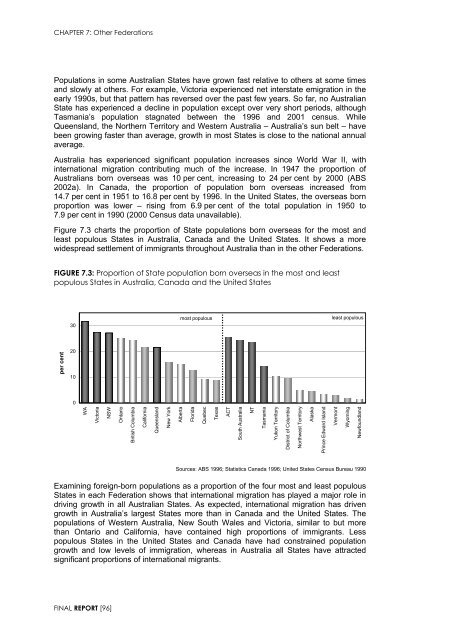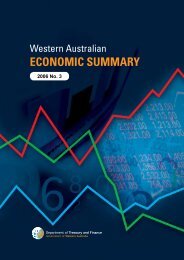Garnaut Fitzgerald Review of Commonwealth-State Funding
Garnaut Fitzgerald Review of Commonwealth-State Funding
Garnaut Fitzgerald Review of Commonwealth-State Funding
Create successful ePaper yourself
Turn your PDF publications into a flip-book with our unique Google optimized e-Paper software.
CHAPTER 7: Other Federations<br />
Populations in some Australian <strong>State</strong>s have grown fast relative to others at some times<br />
and slowly at others. For example, Victoria experienced net interstate emigration in the<br />
early 1990s, but that pattern has reversed over the past few years. So far, no Australian<br />
<strong>State</strong> has experienced a decline in population except over very short periods, although<br />
Tasmania’s population stagnated between the 1996 and 2001 census. While<br />
Queensland, the Northern Territory and Western Australia – Australia’s sun belt – have<br />
been growing faster than average, growth in most <strong>State</strong>s is close to the national annual<br />
average.<br />
Australia has experienced significant population increases since World War II, with<br />
international migration contributing much <strong>of</strong> the increase. In 1947 the proportion <strong>of</strong><br />
Australians born overseas was 10 per cent, increasing to 24 per cent by 2000 (ABS<br />
2002a). In Canada, the proportion <strong>of</strong> population born overseas increased from<br />
14.7 per cent in 1951 to 16.8 per cent by 1996. In the United <strong>State</strong>s, the overseas born<br />
proportion was lower – rising from 6.9 per cent <strong>of</strong> the total population in 1950 to<br />
7.9 per cent in 1990 (2000 Census data unavailable).<br />
Figure 7.3 charts the proportion <strong>of</strong> <strong>State</strong> populations born overseas for the most and<br />
least populous <strong>State</strong>s in Australia, Canada and the United <strong>State</strong>s. It shows a more<br />
widespread settlement <strong>of</strong> immigrants throughout Australia than in the other Federations.<br />
FIGURE 7.3: Proportion <strong>of</strong> <strong>State</strong> population born overseas in the most and least<br />
populous <strong>State</strong>s in Australia, Canada and the United <strong>State</strong>s<br />
30<br />
most populous<br />
least populous<br />
per cent<br />
20<br />
10<br />
0<br />
WA<br />
Victoria<br />
NSW<br />
Ontario<br />
British Columbia<br />
California<br />
Queensland<br />
New York<br />
Alberta<br />
Florida<br />
Quebec<br />
Texas<br />
ACT<br />
South Australia<br />
NT<br />
Tasmania<br />
Yukon Territory<br />
District <strong>of</strong> Columbia<br />
Northwest Territory<br />
Alaska<br />
Prince Edward Island<br />
Vermont<br />
Wyoming<br />
Newfoundland<br />
Sources: ABS 1996; Statistics Canada 1996; United <strong>State</strong>s Census Bureau 1990<br />
Examining foreign-born populations as a proportion <strong>of</strong> the four most and least populous<br />
<strong>State</strong>s in each Federation shows that international migration has played a major role in<br />
driving growth in all Australian <strong>State</strong>s. As expected, international migration has driven<br />
growth in Australia’s largest <strong>State</strong>s more than in Canada and the United <strong>State</strong>s. The<br />
populations <strong>of</strong> Western Australia, New South Wales and Victoria, similar to but more<br />
than Ontario and California, have contained high proportions <strong>of</strong> immigrants. Less<br />
populous <strong>State</strong>s in the United <strong>State</strong>s and Canada have had constrained population<br />
growth and low levels <strong>of</strong> immigration, whereas in Australia all <strong>State</strong>s have attracted<br />
significant proportions <strong>of</strong> international migrants.<br />
FINAL REPORT [96]

















